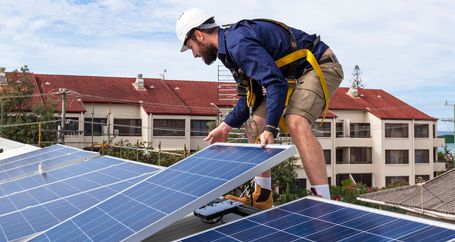"Our monthly electricity bill is about 25 percent lower than what we were paying before."
— Maureen Swift
Maureen Swift has been buying energy-efficient light bulbs for as long as she can remember.
Over time, she has also swapped old shower heads with low-flow models, and now composts most food waste from her family’s meals. When Swift needed to replace the windows in her Long Island, New York home, she says it was a no-brainer to choose new, energy-efficient, double-pane sashes. She wasn’t surprised by the “Earth mama” quips from her husband; what shocked her was how quickly the new windows impacted her energy bill.
Building an energy-efficient home from the ground up might be the eco ideal, but Eric Corey Freed, author of Green Building & Remodeling for Dummies, says homeowners can start reaping the same kind of savings with simpler D I Y home projects that can have a big impact on energy consumption. Best of all, many of these projects take mere minutes to complete.
“It often shocks people when I tell them how much they can save by making super-simple changes,” says Freed.
According to pricing data collected by the U. S. Energy Information Administration (EIA), the average monthly energy bill in the U. S., including electricity, natural gas and heating oil, is around $181. We plugged this average into Freed’s energy-saving DIY home projects to find out how much you could potentially save per month.
Project - 1

Close your fireplace flue.
Project Time: Five minutes
Energy Bill Savings: Up to 10 percent or more
Potential Monthly Savings: $18*
Freed says the fireplace flue is open in 90 percent of the homes he visits to conduct energy-efficiency audits. “That’s like keeping a big window in your ceiling wide open, and then putting a straw in it to suck out heat,” he says.

Close your fireplace flue.
Project Time: Five minutes
Energy Bill Savings: Up to 10 percent or more
Potential Monthly Savings: $18*
Freed says the fireplace flue is open in 90 percent of the homes he visits to conduct energy-efficiency audits. “That’s like keeping a big window in your ceiling wide open, and then putting a straw in it to suck out heat,” he says.

The fast, simple fix: Attach a pull chain to your flue so it’s easier to open and close without getting your hands dirty. Keeping your flue closed when you’re not burning a fire can save you approximately 10 percent (or more) on your energy bill each month.
Project - 2

Reset your hot water heater.
Project Time: Five minutes
Energy Bill Savings: Up to 10 percent or more
Potential Monthly Savings: $18*
Most water heaters are set to about 140 degrees, says Freed. Because this can scald, people tend use a mix of hot and cold water to moderate the temperature. This consumes a lot of energy and wastes water, says Freed.

Reset your hot water heater.
Project Time: Five minutes
Energy Bill Savings: Up to 10 percent or more
Potential Monthly Savings: $18*
Most water heaters are set to about 140 degrees, says Freed. Because this can scald, people tend use a mix of hot and cold water to moderate the temperature. This consumes a lot of energy and wastes water, says Freed.

Consider instead setting your hot water heater to 123 degrees, which is the temperature needed to kill bacteria, according to Freed. The hot water will flow at a reasonable temperature for washing your hands and bathing. Freed also recommends turning the hot water heater temperature way down (or off completely) before going on vacation. If it’s an older water heater, consider wrapping insulation around the unit. Why? If the hot water heater is warm to the touch, heat is escaping. Insulation may make it more efficient. These simple tweaks should drop your bill by up to 10 percent, he says.
Project - 3

Replace power strips with “smart” power strips.
Project Time: 10 minutes
Energy Bill Savings: Up to 10 percent or more
Potential Monthly Savings: $18*
Fact: your plugged-in coffee maker, microwave, stereo sound dock, plasma TV, computer monitor and the countless other devices scattered around your home all consume energy when they’re not in use. In the energy efficiency biz, they’re called “energy vampires.”

Replace power strips with “smart” power strips.
Project Time: 10 minutes
Energy Bill Savings: Up to 10 percent or more
Potential Monthly Savings: $18*
Fact: your plugged-in coffee maker, microwave, stereo sound dock, plasma TV, computer monitor and the countless other devices scattered around your home all consume energy when they’re not in use. In the energy efficiency biz, they’re called “energy vampires.”

If you’re wondering if it’s worth the time to plug and unplug these appliances and devices between uses, the answer according to Freed is: yes. “Energy vampires amount to $10 billion a year in wasted energy costs,” he says. “If you plug your appliances into a smart power strip, which you can find at any major hardware store, it’ll sense when devices aren’t being used and shut itself off.”
"Energy vampires amount to $10 billion a year in wasted energy costs."
— Corey Freed, author of Green Building & Remodeling for Dummies
Bonus project

Shrink-wrap your windows.
Project Time: 90minutes
Energy Bill Savings: Up to 20 percent or more
Potential Monthly Savings: $36.20*
OK, it may sound extreme. And, it’s not exactly the décor choice an interior designer would recommend. But if energy efficient windows aren’t in the budget, Freed says shrink-wrapping windows for the worst months of winter and summer (read: when you won’t be opening windows) could save as much as 15 to 20 percent on your next energy bill.

Shrink-wrap your windows.
Project Time: 90minutes
Energy Bill Savings: Up to 20 percent or more
Potential Monthly Savings: $36.20*
OK, it may sound extreme. And, it’s not exactly the décor choice an interior designer would recommend. But if energy efficient windows aren’t in the budget, Freed says shrink-wrapping windows for the worst months of winter and summer (read: when you won’t be opening windows) could save as much as 15 to 20 percent on your next energy bill.

Look for shrink wrap that’s at least nine millimeters thick, and check the manufacturer’s product details to be sure it’s made with fire retardant material. Concerned about windows looking (and sound) like a crinkly plastic bag? Be strategic about which ones you wrap, focusing on windows typically hidden behind drapes or pretty blinds, or in rooms nobody but you and your family see. Do not shrink wrap any window that may be used as a fire escape.
* Potential energy savings are based on pricing data collected by the U. S. Energy Information Administration (EIA) and a $181 average monthly energy bill (including electricity, natural gas and heating oil).

According to the U.S. Energy
Information Administration
(EIA), the average monthly
energy bill in the U.S. is
approximately $181.
Written by
The information contained in this page is provided for general informational purposes only. The information is provided by Farmers® and while we endeavor to keep the information up to date and correct, we make no representations or warranties of any kind, express or implied, about the completeness, accuracy, reliability, suitability or availability with respect to this article or the information, products, services or related graphics, if any, contained in this article for any purpose. The information is not meant as professional or expert advice, and any reliance you place on such information is therefore strictly at your own risk.
Related articles

Is Your Home Ready For Solar Power?


